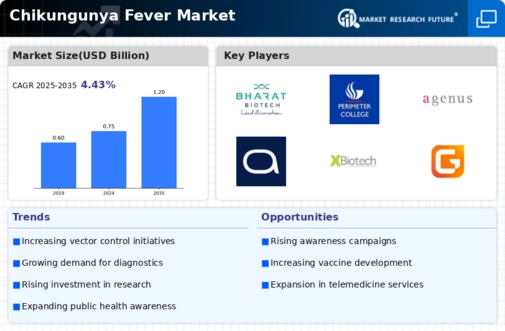The Global Chikungunya Fever Market is witnessing significant growth due to a rise in the incidence of chikungunya cases across various regions. As a vector-borne disease primarily transmitted by mosquitoes, the market is characterized by intense competition among pharmaceutical and biotechnology companies striving to develop effective vaccines and therapeutics.
Companies are increasingly focused on research and development activities to stay ahead in this evolving market, leveraging strategic collaborations, partnerships, and government initiatives aimed at combating the disease.
The competitive landscape features a combination of well-established players and emerging biotech firms, each contributing innovative solutions while addressing the challenges posed by chikungunya's epidemiology.
Overall, the market is becoming more sophisticated with advancements in technologies, targeting not only the medical aspects but also improving public health infrastructure to minimize the impact of outbreaks.
Bharat Biotech has positioned itself as a key player in the Global Chikungunya Fever Market by leveraging its extensive experience in vaccine development and manufacture. The company is known for its robust research and development capabilities, which enable it to develop innovative solutions such as its chikungunya vaccine candidates.
Bharat Biotech capitalizes on its solid regulatory compliance and manufacturing proficiency to enhance its market presence. The company has established significant collaborations with international health organizations, allowing it to extend its footprint beyond local markets.
Its commitment to addressing emerging infectious diseases through continuous investment in R&D and its focus on quality assurance further solidify its strengths in the global arena, enabling Bharat Biotech to be a prominent contributor to the efforts against chikungunya fever.
Merck and Co. has made substantial strides in the Global Chikungunya Fever Market, where it is recognized for its formidable presence and scientific advancements. The company is actively involved in developing and promoting vaccines and therapeutic interventions against chikungunya, leveraging its strong R&D capacity and global market reach.
Merck's commitment to public health is evident through its collaborations with other leading organizations and stakeholders, aiming to combat mosquito-borne diseases globally. Key products and services offered by Merck include vaccine candidates in various stages of clinical trials, emphasizing its progress in mitigating chikungunya-related morbidity.
The company’s strengths lie in its well-established distribution network, extensive resources for clinical development, and a solid history of successful mergers and acquisitions that enhance its product portfolio and market capabilities. This strategic positioning enables Merck to remain competitive in responding to the challenges posed by chikungunya fever in global markets.





















